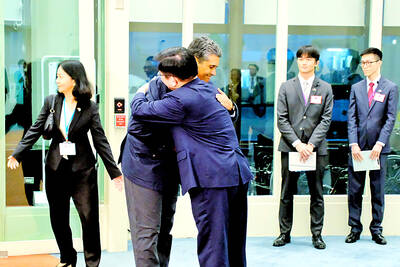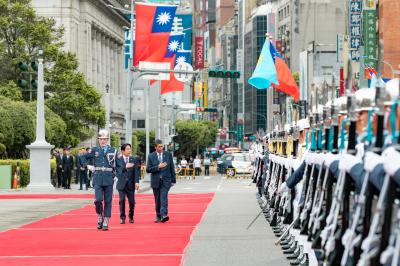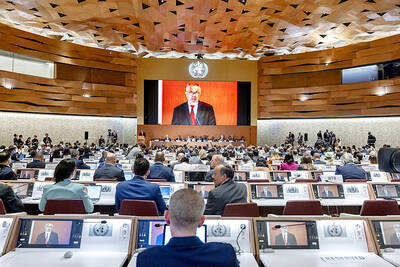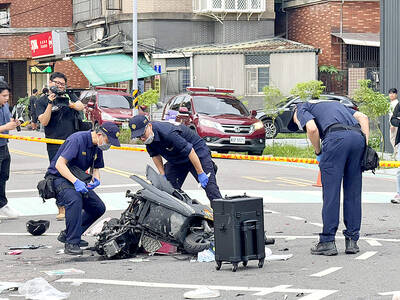Taiwan’s sovereign status was determined by the Treaty of San Francisco on Sept. 8, 1951, not the Cairo Declaration in 1943, nor the Potsdam Declaration of 1945, Taiwan Solidarity Union Legislator Hsu Chung-hsin (許忠信) said on Friday, ahead of the 62nd anniversary of the treaty’s signing.
“Only the Treaty of San Francisco — not the two declarations made during World War II — is recognized as a legitimate international law. The Chinese Nationalist Party [KMT] has been cheating Taiwanese by claiming that Taiwan was returned to the Republic of China [ROC] government,” Hsu, a former Academia Historica president, told a news conference.
Article 2 of the San Francisco Treaty, signed between Japan and most of the Allied powers, states that “Japan renounces all right, title and claim to Formosa and the Pescadores (澎湖),” while the Treaty of Taipei — the peace treaty signed between the ROC and Japan on April 28, 1952 — declares Japan’s “renouncement to all right, title and claim to Taiwan (Formosa) and Penghu (the Pescadores) as well as the Spratly Islands [Nansha Islands, 南沙群島] and the Paracel Islands [Xisha Islands, 西沙群島],” Hsu said.
Japan has never said which country Taiwan belonged to and “the only sure thing was that Taiwan’s sovereignty has been separated from that of China,” he said.
President Ma Ying-jeou’s (馬英九) claim that sovereignty over Taiwan was returned to the ROC with Tokyo’s surrender is a distortion of history because the surrender is not a transfer of sovereignty, the lawmaker said.
Even more dangerous is that Ma’s position echoes that of Beijing’s, which means that China could use this as a base from which to claim Taiwan as its territory, Hsu said.
In addition, KMT officials would not have been able to arrive in Taiwan after World War II without the help of US naval vessels and Chiang Kai-shek (蔣介石) accepted the surrender of Japanese troops in Taiwan after Allied Forces General Douglas MacArthur assigned him to do so, said Chang Yen-hsien (張炎憲), another former Academia Historica president.
“Chiang’s military occupation of Taiwan does not mean that the KMT regime obtained sovereignty over it,” Chang said.

Palauan President Surangel Whipps Jr arrived in Taiwan last night to kick off his first visit to the country since beginning his second term earlier this year. After arriving at Taoyuan International Airport at around 6:30 pm, Whipps and his delegation were welcomed by Minister of Foreign Affairs Lin Chia-lung (林佳龍). Speaking to gathered media, the Palauan leader said he was excited and honored to be back in Taiwan on his first state visit to Taiwan since he was sworn in this January. Among those traveling with Whipps is Minister of State Gustav N. Aitaro, Public Infrastructure

President William Lai (賴清德) yesterday thanked Palau for its continued support of Taiwan's international participation, as Taipei was once again excluded from the World Health Assembly (WHA) currently taking place in Switzerland. "Palau has never stopped voicing support for Taiwan" in the UN General Assembly, the WHO and other UN-affiliated agencies, Lai said during a bilateral meeting with visiting Palau President Surangel Whipps Jr. "We have been profoundly touched by these endorsements," Lai said, praising the Pacific island nation's firm support as "courageous." Lai's remarks came as Taiwan was excluded for the ninth consecutive year from the WHA, which is being held in

RESOLUTIONS DEBATE: Taiwan’s allies said that UN and WHA resolutions cited by China and other nations ‘do not determine Taiwan’s participation in WHO activities’ A proposal to invite Taiwan to this year’s World Health Assembly (WHA) was rejected on Monday, resulting in Taipei’s absence from the annual meeting for a ninth consecutive year, although partners spoke up for Taiwan’s participation at the first day of the meeting. The first agenda item after the opening was a “two-on-two debate” on a proposal to invite Taiwan to participate at the WHA as an observer. Similar to previous years, two countries made statements in favor of the proposal, while two others expressed their opposition. Philippine Secretary of Health Teodoro Herbosa, president of the 78th WHA, accepted the WHA General Committee’s

At least three people died and more than a dozen were injured yesterday afternoon when a vehicle struck a group of pedestrians in New Taipei City’s Sansia District (三峽). The incident happened at about 4pm when a car rammed into pedestrians at an intersection near Bei Da Elementary School. Witnesses said the sedan, being driven at a high speed, ran a red light, knocking scooters out of the way and hitting students crossing the road before careening into a median near the intersection of Guocheng and Guoguang streets. The incident resulted in three deaths and 13 injuries, including the driver, a 78-year-old man